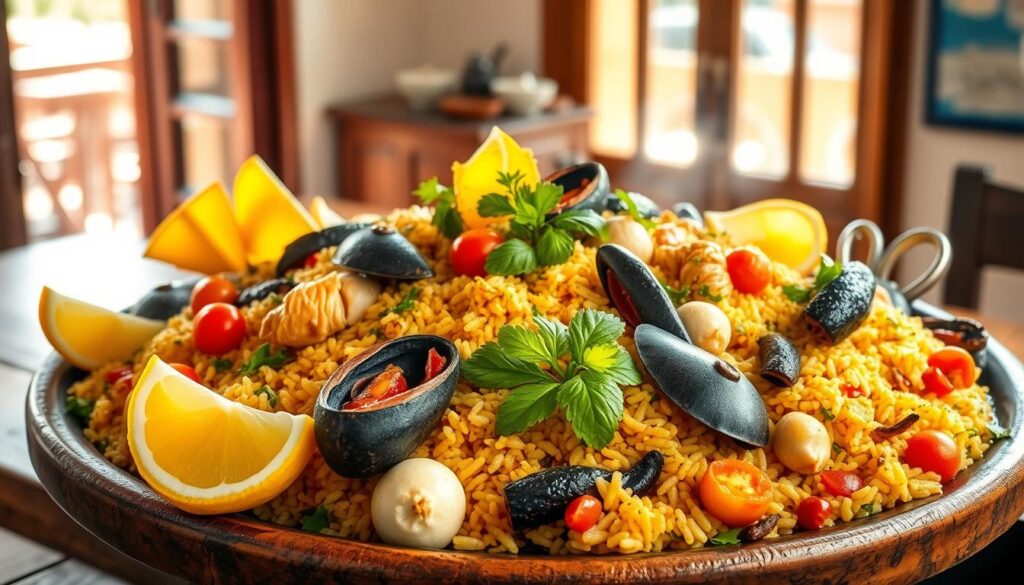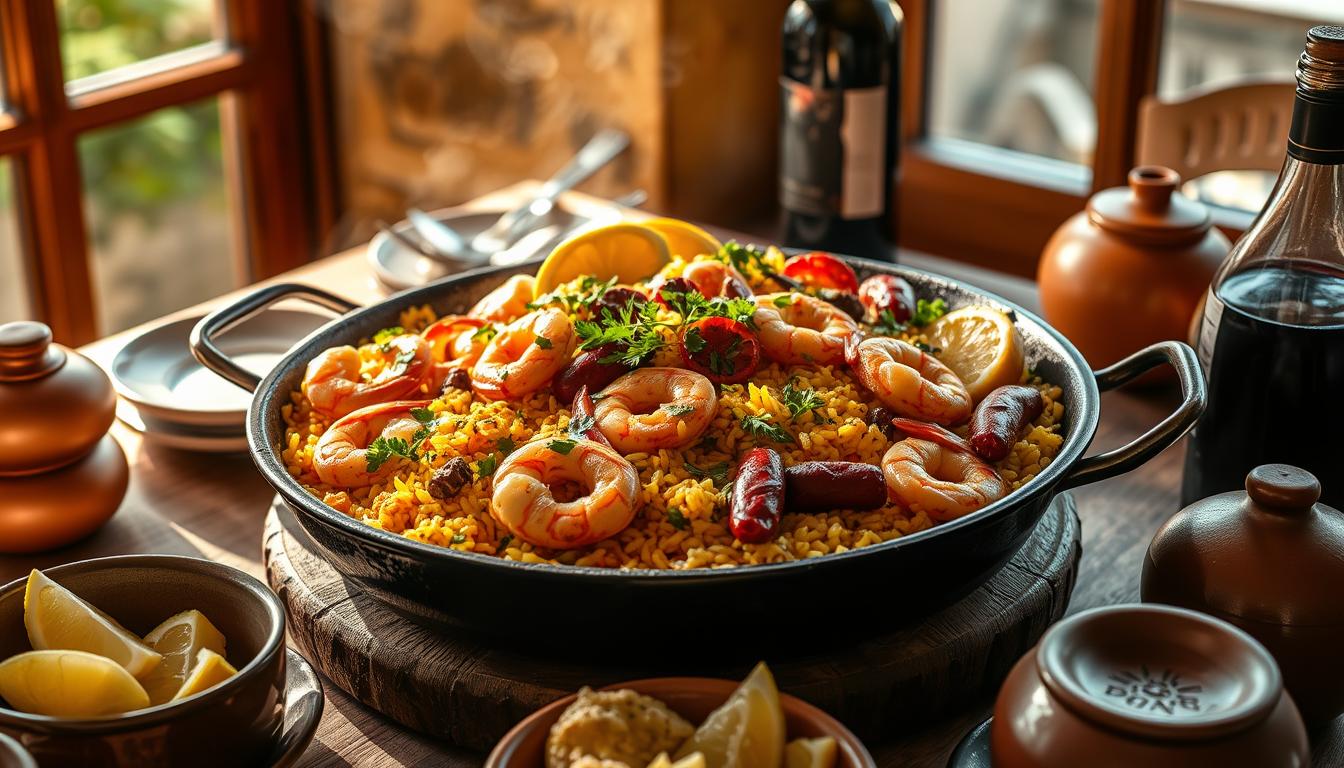Paella is a Spanish rice dish that captures the heart of Valencia’s food tradition. It was born in the mid-19th century in eastern Spain. It started as a simple meal for farmers but now is loved worldwide.
Paella is more than a meal; it’s a celebration of community and taste. It comes from Valencia’s Albufera region. This dish went from a simple worker’s lunch to a famous dish enjoyed by all.
Exploring paella is like diving into Spanish food history. It’s made traditionally outdoors over a wood fire. This shows the importance of sharing meals in Spanish culture.
Key Takeaways
- Paella originated in Valencia during the mid-19th century
- Traditionally prepared as a communal outdoor cooking experience
- Represents the social fabric of Spanish food culture
- Uses locally sourced ingredients from the Albufera region
- Evolved from a worker’s meal to an international delicacy
The Rich Heritage of Spanish Rice Dishes
Explore Valencia cuisine, where paella stands out as a true masterpiece. It’s deeply connected to Spanish traditions. This dish’s story starts in Valencia’s Albufera region, known for its great rice.

Paella began as a simple farmer’s meal. It shows how local workers turned basic ingredients into something special. By the 18th century, it became a national treasure.
Origins in Valencia’s Agricultural Landscape
The Albufera region was key in paella’s growth. It offered perfect conditions for rice. Farmers created special cooking methods that shaped saffron rice:
- Using large, shallow pans to spread heat evenly
- Adding local proteins like rabbit and chicken
- Using rice that absorbs flavors well
Evolution of a Culinary Icon
Paella grew from a simple meal to a symbol of Spanish welcome. The 19th century brought saffron, making it a sign of wealth and culture.
Traditional Ingredients and Cooking Methods
True Valencia cuisine uses specific ingredients and methods. Paella often includes:
- Short-grain Bomba or Calasparra rice
- Saffron for its color and taste
- Local proteins like chicken, rabbit, or seafood
- Aromatic vegetables and spices
Paella is more than a meal. It’s a celebration of Spanish culinary heritage and community spirit.
Understanding Traditional Paela Preparation

Learning to make a Spanish rice dish is all about mastering special tools and techniques. The paellera, a wide, shallow pan, is at the heart of this tradition. It gives the dish its unique flavor and texture. To start making authentic paella, you need the right tools and ingredients.
The secret to perfect paella is choosing the right rice. Bomba rice is the best choice because it can hold three times more liquid than regular rice. This rice keeps each grain separate and full of flavor.
Important preparation techniques include:
- Selecting a pan sized appropriately for your group (10-18 inches)
- Using high-quality olive oil for sautéing
- Creating a flavorful sofrito base
- Achieving the prized socarrat – the crispy rice bottom
Your cooking process should follow a careful rhythm. Start by sautéing ingredients on high heat, then switch to medium heat for rice cooking. Finish by briefly increasing heat to get that crispy layer. The whole process takes about 30 minutes, with a 5-minute resting period to let flavors meld.
Remember, making authentic Spanish rice dishes takes patience and precision. Each step is important for creating a memorable culinary experience that honors Spain’s rich food heritage.
Essential Ingredients for Authentic Spanish Paela
To make a true Spanish paela, you need the right ingredients. These ingredients add depth and tradition to this famous dish. They turn simple parts into a true work of art.
The base of a great paela is saffron rice and top-notch proteins. Your choice of ingredients is key to the dish’s success.
The Magic of Saffron Rice
Saffron rice is the heart of authentic paela. It gives the dish a golden color and a rich, complex taste. When picking saffron rice, look for:
- Short-grain varieties like Bomba or Calasparra
- Rich, deep yellow color
- Ability to absorb flavors while keeping its texture
Proteins That Define Regional Flavors
Traditional proteins vary by Spanish region. Valencian recipes often use rabbit and chicken. Coastal areas feature lots of seafood. Modern recipes might add chorizo for a smoky flavor.
Vegetable Selections
Vegetables add flavor, not just bulk. Common choices include:
- Tomatoes
- Bell peppers
- Green beans
- Artichokes
Every region has its own twist, making each paela unique. Your journey through Spanish cuisine starts with these basic ingredients.
Cooking Techniques and Equipment
Learning to make a Spanish rice dish is all about mastering special cooking techniques and using the right equipment. The traditional way to make paella is over an open flame. This method gives the dish a smoky flavor that’s hard to get with regular kitchen tools.
The heart of making authentic paella is the paellera. It’s a wide, shallow pan made just for paella. These pans come in different sizes to fit groups of all sizes:
- Small 30 cm pan: Serves 2-3 people
- Medium 38 cm pan: Serves 4-5 people
- Large 55 cm pan: Serves 10-12 people
When cooking paella, keep an eye on the rice layer. It should be 1-2 centimeters thick for the best texture and even cooking. Traditional pans are made of polished steel, but you can also find modern ones in stainless steel and non-stick materials.
If you can’t cook outdoors, stovetop and oven methods can still make great paella. The secret is to get that crispy bottom layer called socarrat. It’s what makes a Spanish rice dish truly special.
Pro tip: Invest in a proper paella pan to elevate your cooking experience and authenticity.
Regional Variations Across Spain
Spanish paella changes a lot across different regions. This shows the amazing variety in Valencia cuisine. Each place adds its own special touch to this seafood rice dish, using local ingredients and traditions.
Valencian Style: The Authentic Roots
In Valencia, traditional paella stays true to its roots. It uses white rice, green beans, chicken, rabbit, and sometimes snails. The key part is the socarrat – a crispy, caramelized rice layer that locals love the most.
Coastal Seafood Interpretations
Coastal areas have made seafood rice their own with creativity. You’ll find:
- Paellas full of shrimp and mussels
- Squid ink black rice (arroz negro)
- Lobster-infused versions
Modern Culinary Innovations
Today, chefs are making paella in new ways. They add artichokes, asparagus, and exotic mushrooms to vegetarian options. Some places even grill or bake paella, trying something different from the usual open-flame cooking.
“Paella is not just a dish, it’s a celebration of Spanish regional diversity.” – Spanish Chef
Seasonal Adaptations
Seasonal ingredients are key in paella’s changes. In summer, you get lighter seafood versions. Winter brings heartier meats like lamb or goat from the mountains.
The Art of Perfect Rice Texture
Creating the perfect Spanish rice dish is all about precision and knowing the traditional ways. The key is the rice’s texture, which makes a meal special. You aim for tender grains and a crispy bottom layer called socarrat.
To get the rice just right, follow these steps:
- Choose short-grain rice like Bomba or Calasparra
- Keep the right amount of liquid to rice
- Use a wide paella pan for even heat
- Don’t stir the rice while it cooks
The secret to great Spanish rice is controlling the heat and timing. You need a gentle simmer to soak up flavors without mushiness. Cook for 18-20 minutes, then rest for 5-10 minutes after turning off the heat.
“The perfect paella is a delicate dance of temperature, ingredients, and technique” – Spanish Culinary Tradition
To get the socarrat right, heat up the pan in the last minutes. You’ll hear a crackling sound when the rice’s bottom turns golden and crispy. This takes practice but is the essence of Spanish rice mastery.
Don’t make common mistakes like stirring too much, using the wrong rice, or wrong liquid amounts. Your patience and focus will make your paella’s rice a success.
Pairing and Serving Traditions
Paella is more than a meal in Spanish culture. It’s a lively way to bring people together. When you make this famous dish, knowing how to serve it can make your cooking journey special.
Serving paella is an art form. It’s about making a meal that everyone will remember. It’s a way to honor Spanish food traditions.
Traditional Accompaniments
To make your paella even better, try these classic sides:
- Fresh lemon wedges for a burst of citrus
- Homemade alioli (garlic mayonnaise)
- Crusty bread for dipping in juices
- A simple green salad with olive oil dressing
Wine and Beverage Selections
Choosing the right drink can make your paella even better. Spanish wines like Albariño or Tempranillo pair well. For a traditional choice, try sangria or a crisp local white.
Proper Serving Etiquette
“In Valencia, paella is not just food—it’s a celebration of togetherness.”
Authentic paella serving has its own traditions:
- Serve from the traditional wide paella pan
- Share plates for everyone to enjoy together
- Let guests savor the socarrat (crispy rice bottom)
- Serve family-style to foster conversation and connection
By following these serving traditions, you’ll turn a simple meal into a true Spanish dining experience.
Cultural Significance and Celebrations
Paella is more than a dish in Spanish culture. It’s a symbol of community, celebration, and Valencia cuisine. This tradition shows the spirit of Spanish hospitality and social connection.
In Valencia, paella is a culinary tradition deeply rooted in local heritage. It turns simple gatherings into special events. Families and friends come together for a shared meal. During festivals and special occasions, paella is the star, showing off the region’s gastronomic pride.
- Sueca International Paella Contest attracts chefs from around the world
- World Paella Day celebrated annually on September 20
- Approximately 80% of Spanish households enjoy paella regularly
The cultural importance of Valencia cuisine is clear in paella. Cooking paella is an art form that needs skill, passion, and traditional techniques. It brings people together at family reunions and local festivals. This iconic dish shows the warmth and generosity of Spanish culture.
Paella is not just food—it’s a celebration of life, community, and tradition.
Valencia holds the world record for the largest paella ever made. In 2001, it served an amazing 110,000 people. This shows paella’s power to unite and highlight Spanish culinary excellence.
Conclusion
Exploring paella shows it’s more than a recipe. It’s a lively tradition that brings families together. This dish connects people through food and culture, from Valencia to kitchens around the world.
Paella is a story of love and adaptation. You’ve seen how each area makes it special, using local tastes and traditions. It’s a dish that shows Spain’s rich food culture, whether it’s seafood or meats.
Try making paella in your kitchen. It’s not just cooking; it’s a way to connect with Spanish history. Paella celebrates community, taste, and the joy of eating together.
Your cooking adventure doesn’t stop here. Every time you make paella, you join a tradition that keeps growing. Let paella’s spirit guide your cooking and take you to Spain’s lively kitchens.

